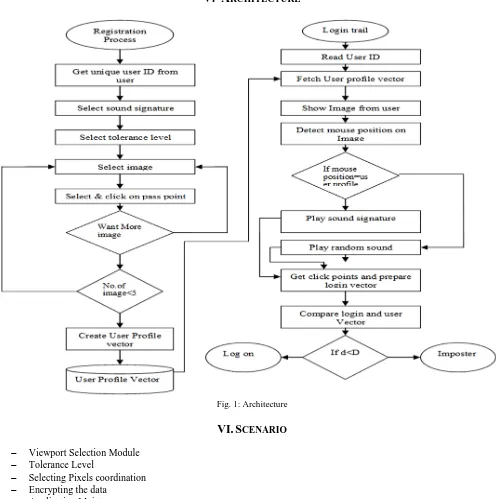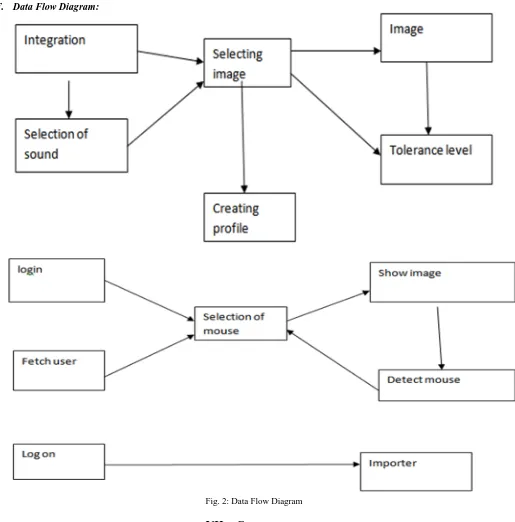Implementing Captcha as Graphical Passwords
Based on Hard AI Problems
U. Anitha S. Shakila
Student Student
Department of Information Technology Department of Information Technology Karpaga Vinayaga College Of Engineering Andtechnology,
Kanchipuram Dt. TamilNadu, India
Karpaga Vinayaga College Of Engineering Andtechnology, Kanchipuram Dt. TamilNadu, India
V. Kavitha
Assistant Professor
Department of Information Technology
Karpaga Vinayaga College Of Engineering Andtechnology, Kanchipuram Dt. TamilNadu, India
Abstract
We present captcha as graphical passwords inmany security primitives square measure supported laborious mathematical issues. Exploitation laborious AI issues for security is rising as AN exciting new paradigm, however has been beneath explored. During this paper, we have a tendency to gift a brand new security primitive supported laborious AI issues, namely, a unique family of graphical watchword systems designed on high of Captcha technology, that we have a tendency to decision Captcha as graphical passwords (CaRP). CaRP is each a Captcha and a graphical watchword theme. CaRP addresses variety of security issues altogether, like on-line guess attacks, relay attacks, and, if combined with dual-view technologies, shoulder-surfing attacks. Notably, a CaRP watchword is found solely probabilistic ally by automatic on-line guess attacks although the watchword is within the search set. CaRP additionally offers a unique approach to deal with the well-known image hotspot drawback in standard graphical watchword systems, like Pass Points, that usually ends up in weak watchword decisions.CaRP isn't a nostrum, however it offers cheap security and usefulness and seems to suit well with some sensible applications for rising on-line security. Keywords: Online security, AI, Security of data, CARP passwords, Captcha as a graphical passwords, Passpoints, Automatic online guessing attacks, Hard AI problems, Hard mathematical problem, image hotspots problem, Shoulder surfing, Attack, Search set
________________________________________________________________________________________________________
I.
I
NTRODUCTIONUsers often create memorable passwords that are easy for attackers to guess, but strong system-assigned passwords are difficult for users to remember. A password authentication system should encourage strong passwords while maintaining memorability. We propose that authentication schemes allow user choice while influencing users toward stronger passwords.We applied this approach to create the first persuasive click-based graphical password system, Persuasive Cued Click-Points (PCCP) and conducted user studies evaluating usability and security. CaRP offers protection against online dictionary attacks on passwords, which have been for long time a major security threat for various online services. This threat is widespread and considered as a top cyber security risk. Defense against online dictionary attacks is a more subtle problem than it might appear. Intuitive countermeasures such as throttling logon attempts do not work well for two reasons:
1) It causes denial-of-service attacks (which were exploited to lock highest bidders out in final minutes of eBay auctions ) and incurs expensive helpdesk costs for account reactivation.
2) It is vulnerable to global password attacks whereby adversaries intend to break into any account rather than a specific one, and thus try each password candidate on multiple accounts and ensure that the number of trials on each account is below the threshold to avoid triggering account lockout.
CaRP also offers protection against relay attacks, an increasing threat to bypass Captchas protection, wherein Captcha challenges are relayed to humans to solve. Koobface was a relay attack to bypass Facebook’s Captcha in creating new accounts. CaRP is robust to shoulder-surfing attacks if combined with dual-view technologies.
II.
E
XISTING SYSTEMwhen entering their latest click-point (at which point they can cancel their attempt and retry from the beginning).It also makes attacks based on hotspot analysis more challenging. Each click results in showing a next-image, in Effect leading users down a “path” as they click on their sequence of points.While the predictability problem can be solved by disallowing user choice and assigning passwords to users, this usually leads to usability issues since users cannot easily remember such random passwords. Number of graphical password systems have been developed, Study shows that text-based passwords suffers with both security and usability problems.
Limitations of Existing System: A.
Using hard AI (Artificial Intelligence) problems for security, initially proposed in [17], is an existing new paradigm. Under this paradigm, the most notable primitive invented is Captcha, which distinguishes human users from computers
by presenting a challenge.
III.
R
ELATED WORKSA large number of graphical password schemes have beenproposed. They can be classified into three categories accordingto the task involved in memorizing and entering passwords: recognition, recall, and cued recall. Each type will be brieflydescribed here. More can be found in a recent review of graphical passwords [1].A recognition-based scheme requires identifying amongdecoys the visual objects belonging to a password portfolio.A typical scheme is Passfaces [2] wherein a user selects a portfolio of faces from a database in creating a password.During authentication, a panel of candidate faces is presentedfor the user to select the face belonging to her portfolio. This process is repeated several rounds, each round with a different panel. A successful login requires correct selection in each round. The set of images in a panel remains the same betweenlogins, but their locations are permuted. Story [20] is similar to Passfaces but the images in the portfolio are ordered, and a user must identify her portfolio images in the correct order.Déjà Vu [21] is also similar but uses a large set of computer generated“random-art” images. Cognitive Authentication [22requires a user to generate a path through a panel of images as follows: starting from the top-left image, moving down if the image is in her portfolio, or right otherwise. The user identifies among decoys the row or column label that the path ends.
IRCs have also been studied. Asirra was found to be susceptible to machine-learning attacks [24]. IRCs based on binary object classification or identification of one concrete type of objects is likely insecure [25]. Multi-label classification problems are considered much harder than binary classification problems. Captcha can be circumvented through relay attacks wherebyCaptcha challenges are relayed to human solvers, whose answers are fed back to the targeted application.
IV.
P
ROPOSED SYSTEMV.
A
RCHITECTUREFig. 1: Architecture
VI.
S
CENARIO Viewport Selection Module Tolerance Level
Selecting Pixels coordination Encrypting the data
Application Maintenance
Viewport Selection Mode: A.
In our project, first we brows and select an image for our security process. In that image we put viewport selection. This viewport is movable in overall image. We select image pixels in that viewport only.
Fixing Tolerance Level: B.
Tolerance level used for get coordinated pixels for our selected click points in our image.
Selecting Pixels Coordination: C.
Encrypting the Data: D.
In registration process, our all information stored our database in encrypted form. We can use Data Encryption Standard (DES) algorithm for encrypt and decrypt process.
Application Maintenance: E.
Final module of our project as application maintenance. That is, to maintain our application with more and more security. Such as username and image click points.
Data Flow Diagram: F.
Fig. 2: Data Flow Diagram
VII.
C
ONCLUSIONautomatic online guessing attacks including brute-force attacks, a desiredsecurity property that other graphical password schemes lack. Hotspots in CaRP images can no longer be exploited to mountautomatic online guessing attacks, an inherent vulnerability inmany graphical password systems. CaRP forces adversaries to resort to significantly less efficient and much more costly human-based attacks. In addition to offering protection fromonline guessing attacks, CaRP is also resistant to Captcharelay attacks, and, if combined with dual-view technologies,shoulder-surfing attacks. CaRP can also help reduce spam emails sent from a Web email service.Our usability study of two CaRP schemes we have implemented is encouraging. For example, more participants considered AnimalGrid and Click Text easier to use than PassPoints and a combination of text password and Captcha.Both AnimalGrid and ClickText had better password memorability than the conventional text passwords. On the other hand,the usability of CaRP can be further improved by using images of different levels of difficulty based on the login history ofthe user and the machine used to log in. The optimal trade-off between security and usability remains an open question forCaRP, and further studies are needed to refine CaRP for actual deployments.
Like Captcha, CaRP utilizes unsolved AI problems. However, a password is much more valuable to attackers thana free email account that Captcha is typically used to protect. Therefore there are more incentives for attackers to hack CaRPthan Captcha. That is, more efforts will be attracted to thefollowing win-win game by CaRP than ordinary Captcha:
If attackers succeed, they contribute to improving AI byproviding solutions to open problems such as segmenting2D texts. Otherwise, our system stays secure, contributingto practical security. As a framework, CaRP does not relyon any specific Captcha scheme. When one Captcha schemeis broken, a new and more secure one may appear and be converted to a CaRP scheme.Overall, our work is one step forward in the paradigm of using hard AI problems for security. Of reasonable security and usability and practical applications, CaRP has good potential for refinements, which call for useful future work. More importantly, we expect CaRP to inspire new inventions of such AI based security primitives.
R
EFERENCES[1] R. Biddle, S. Chiasson, and P. C. van Oorschot, “Graphical passwords: Learning from the first twelve years,” ACM Comput. Surveys, vol. 44, no. 4, 2012.
[2] (2012, Feb.). The Science Behind Passfaces [Online]. Available: http://www.realuser.com/published/ScienceBehindPassfaces.pdf.
[3] P. C. van Oorschot, A. Salehi-Abari, and J. Thorpe, “Purely automated attacks on passpoints-style graphical passwords,” IEEE Trans. Inf. Forensics Security, vol. 5, no. 3, pp. 393–405, Sep. 2010.
[4] P. C. van Oorschot and J. Thorpe, “Exploiting predictability in click based graphical passwords,” J. Comput. Security, vol. 19, no. 4, pp. 669–702, 2011.
[5] HP TippingPoint DVLabs, Vienna, Austria. (2010). Top Cyber Security Risks Report, SANS Institute and Qualys Research Labs [Online]. Available: http://dvlabs.tippingpoint.com/toprisks2010
[6] M. Alsaleh, M. Mannan, and P. C. van Oorschot, “Revisiting defenses against large-scale online password guessing attacks,” IEEE Trans. Dependable Secure Comput., vol. 9, no. 1, pp. 128–141, Jan./Feb. 2012.
[7] HP TippingPoint DVLabs, New York, NY, USA. (2011). The Mid-Year Top Cyber Security Risks Report [Online]. Available: http://h20195.www2.hp.com/v2/GetPDF.aspx/4AA3-7045ENW.pdf
[8] S. Kim, X. Cao, H. Zhang, and D. Tan, “Enabling concurrent dual views on common LCD screens,” in Proc. ACM Annu. Conf. Human Factors Comput. Syst., 2012, pp. 2175–2184.
[9] S. Li, S. A. H. Shah, M. A. U. Khan, S. A. Khayam, A.-R. Sadeghi, and R. Schmitz, “Breaking e-banking CAPTCHAs,” in Proc. ACSAC, 2010, pp. 1–10.
[10] L. Wang, X. Chang, Z. Ren, H. Gao, X. Liu, and U. Aickelin, “Against spyware using CAPTCHA in graphical password scheme,” in Proc. IEEE Int. Conf. Adv. Inf. Netw. Appl., Jun. 2010, pp. 1–9.
[11] J. Bonneau, “The science of guessing: Analyzing an anonymized corpus of 70 million passwords,” in Proc. IEEE Symp. Security Privacy, Jun. 2012, pp. 20–25.
[12] M. Alsaleh, M. Mannan, and P. C. van Oorschot, “Revisitingdefenses against large-scale online password guessing attacks,” IEEETrans. Dependable Secure Comput., vol. 9, no. 1, pp. 128–141,Jan./Feb. 2012.
[13] B. B. Zhu et al., “Attacks and design of image recognition CAPTCHAs,”in Proc. ACM CCS, 2010, pp. 187–200.

